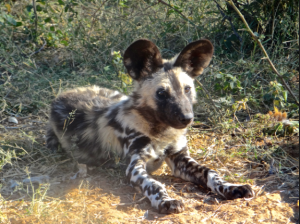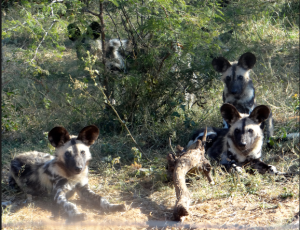“Wild” Dogs


In 2005, on my first trip with my family to South Africa, I saw a pack of wild dogs and they immediately became my favourite African animal (elephants being a very close second). As our landrover was slowing down to find potential thirsty animals at a watering hole, an impala shot out of the tall grass behind us with a wild dog charging after it, full speed. Roughly 8 more dogs emerged from the grass, and the dogs chased the impala into the water, where they eventually gave up and scattered off. I was in such awe of how beautiful and communicative these animals were, with their painted coats and their high pitched yips to one another. Our guide explained how incredibly rare it was to see a pack of wild dogs because their population was seriously suffering, and now I understand why.
I have yet to see a true ‘wild’ dog since, as there are only 3,000-4,000 left in Africa and they are one of the world’s most endangered mammals. Despite the low probability of me ever seeing one in the wild again, the wild dog remains my favourite animal. They are so unbelievably efficient in their hunting and social structure that I have nothing but admiration and love for these scruffy intelligent creatures.
While hunting, a wild dog pack is 80% successful, and when compared to the lion’s 20% success rate, it is clear that wild dogs have earned their alternative name, the Cape Hunting Dog. With their stamina, the dogs tire their prey over chases lasting up to 5 kilometers, eventually using the strength of every hunting member to bring the prey down. Wild dogs are unique from hyenas and lions in that they do not fight each other for food, but rather share it amongst themselves. Each pack is led by a monogamous breeding pair, and each pack member helps look after the pups. This means that after a kill, the wild dogs will bring back food for the pups, the pack members that stayed behind as guard dogs, and the weak or injured dogs that couldn’t join the hunt.
A century ago, there were packs of over 100 wild dogs roaming the Serengeti, and now packs average at around 10 individuals. There are many reasons why the wild dog population is plummeting, and it saddens me that they are all human related. We have fragmented their habitat with human development, cutting their large roaming areas into smaller, contained spaces. Wild dogs are regarded as pests to local farmers, and these farmers will shoot an entire pack of dogs if necessary to protect their cattle. The most significant threat to the wild dog population is through human encroachment on the wild dog population, and specifically the introduction of domesticated dogs that carry diseases such as canine distemper and rabies. These diseases, once passed on to a member of a wild dog pack, spread very quickly and can kill off the entire pack, no matter the size.
It makes me angry that I may never be able to see these dogs in the wild, where they belong, because in the past couple months, I have only been able to see wild dogs in captivity. At the Harnas Wildlife Foundation in Namibia, where I volunteered for 2 weeks prior to arriving in South Africa, there were many wild dogs that we occasionally got to feed. Watching the dogs devour the donkey intestines we threw over the electric fence was amazing, but in no way did it compare to the thrill of seeing a wild pack in their element, chasing down an impala. I saw several more at the Moholoholo Rehabilitation Center in South Africa, and hidden behind my smile, from gazing at such beautiful creatures, was sadness. I felt sad that these ‘painted wolves’ couldn’t run and roam where they pleased. I felt sad that they were stuck in enclosures, but most of all, I felt sad that of the 3,500 wild dogs left in Africa, many of those individuals are not even ‘wild’.
I have this sadness for all animals; this sadness that so many individuals of the remaining population are stuck in captivity. There are 3,000 wild tigers left in the world, but there are 4,000 tigers in captivity in Texas alone, and 5,000 tigers kept captive in China. The total population of African lions is around 24,000 individuals, but 8,000 of these are kept and raised behind fences, mostly used for canned hunting purposes. Finally, the amount of wild Asian elephants is only 10% of the total remaining population. These animals should not be stuck in enclosures or as pets or circus workers. This exploitation of such majestic, beautiful creatures is inhumane and simply wrong.
At this point, when I see my future with kids and grand kids, I wonder if they will be able to see wild dogs, tigers, or lions in the actual wild, or just in zoos or breeding centers to ‘keep the species alive’. If the species is extinct in the wild, shouldn’t that be it? If the species is no longer able to flourish in their true environment, hunting and providing for themselves, then we are selfish for keeping these animals in cages for our own viewing benefit. Haven’t we done enough? We have effectively destroyed these animals’ habitats and exploited them for economic gain. If their populations continue to decrease, all that will be left is animals in fences, completely reliable on humans for food and survival.
Wild dogs flourish in packs, hunting prey and protecting one another. They need the wild, not enclosures. We humans are destroying their chance of persevering as a species in the wild due to our encroachment on their habitat, so we have to do something about it and stop the captivity of these beautifully wild creatures.
– Kennedy Holland